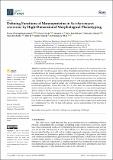Notice
This is not the latest version of this item. The latest version can be found at:https://dspace.mit.edu/handle/1721.1/133173.3
Defining Functions of Mannoproteins in Saccharomyces cerevisiae by High-Dimensional Morphological Phenotyping
| dc.contributor.author | Ghanegolmohammadi, Farzan | |
| dc.contributor.author | Okada, Hiroki | |
| dc.contributor.author | Liu, Yaxuan | |
| dc.contributor.author | Itto-Nakama, Kaori | |
| dc.contributor.author | Ohnuki, Shinsuke | |
| dc.contributor.author | Savchenko, Anna | |
| dc.contributor.author | Bi, Erfei | |
| dc.contributor.author | Yoshida, Satoshi | |
| dc.contributor.author | Ohya, Yoshikazu | |
| dc.date.accessioned | 2021-10-27T17:15:57Z | |
| dc.date.available | 2021-10-27T17:15:57Z | |
| dc.date.issued | 2021-09-17 | |
| dc.identifier.uri | https://hdl.handle.net/1721.1/133173 | |
| dc.description.abstract | Mannoproteins are non-filamentous glycoproteins localized to the outermost layer of the yeast cell wall. The physiological roles of these structural components have not been completely elucidated due to the limited availability of appropriate tools. As the perturbation of mannoproteins may affect cell morphology, we investigated mannoprotein mutants in <i>Saccharomyces cerevisiae</i> via high-dimensional morphological phenotyping. The mannoprotein mutants were morphologically classified into seven groups using clustering analysis with Gaussian mixture modeling. The pleiotropic phenotypes of cluster I mutant cells (<i>ccw12</i>Δ) indicated that <i>CCW12</i> plays major roles in cell wall organization. Cluster II (<i>ccw14</i>Δ, <i>flo11</i>Δ, <i>srl1</i>Δ, and <i>tir3</i>Δ) mutants exhibited altered mother cell size and shape. Mutants of cluster III and IV exhibited no or very small morphological defects. Cluster V (<i>dse2</i>Δ, <i>egt2</i>Δ, and <i>sun4</i>Δ) consisted of endoglucanase mutants with cell separation defects due to incomplete septum digestion. The cluster VI mutant cells (<i>ecm33</i>Δ) exhibited perturbation of apical bud growth. Cluster VII mutant cells (<i>sag1</i>Δ) exhibited differences in cell size and actin organization. Biochemical assays further confirmed the observed morphological defects. Further investigations based on various omics data indicated that morphological phenotyping is a complementary tool that can help with gaining a deeper understanding of the functions of mannoproteins. | en_US |
| dc.publisher | Multidisciplinary Digital Publishing Institute | en_US |
| dc.relation.isversionof | http://dx.doi.org/10.3390/jof7090769 | en_US |
| dc.rights | Creative Commons Attribution | en_US |
| dc.rights.uri | https://creativecommons.org/licenses/by/4.0/ | en_US |
| dc.source | Multidisciplinary Digital Publishing Institute | en_US |
| dc.title | Defining Functions of Mannoproteins in Saccharomyces cerevisiae by High-Dimensional Morphological Phenotyping | en_US |
| dc.type | Article | en_US |
| dc.identifier.citation | Journal of Fungi 7 (9): 769 (2021) | en_US |
| dc.contributor.department | Massachusetts Institute of Technology. Department of Biological Engineering | |
| dc.identifier.mitlicense | PUBLISHER_CC | |
| dc.eprint.version | Final published version | en_US |
| dc.type.uri | http://purl.org/eprint/type/JournalArticle | en_US |
| eprint.status | http://purl.org/eprint/status/PeerReviewed | en_US |
| dc.date.updated | 2021-09-25T23:33:25Z | |
| dspace.date.submission | 2021-09-25T23:33:25Z | |
| mit.license | PUBLISHER_CC | |
| mit.metadata.status | Authority Work and Publication Information Needed | en_US |
